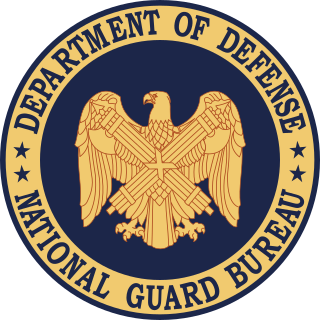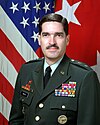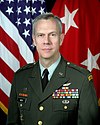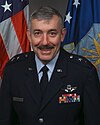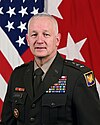Vice Chief of the National Guard Bureau
Second highest-ranking officer of the United States National Guard From Wikipedia, the free encyclopedia
The vice chief of the National Guard Bureau (VCNGB) is the second highest-ranking officer of the National Guard Bureau, which is a joint activity of the United States Department of Defense. The vice chief is also the second in charge of the National Guard; which is a joint reserve component of the United States Army and the United States Air Force. The vice chief serves as the principal advisor to the chief of the National Guard Bureau and the secretary of defense, through the chairman of the Joint Chiefs of Staff, on matters involving non-federalized National Guard forces and on other matters as determined by the United States Secretary of Defense. The vice chief also serves as the principal adviser to the secretary of the Army, the secretary of the Air Force, the chief of staff of the Army, and the chief of staff of the Air Force, on matters relating to federalized forces of the United States National Guard and its sub-components; the Army National Guard, and the Air National Guard.
| Vice Chief of the National Guard Bureau | |
|---|---|
 Seal of the National Guard Bureau | |
 Flag of the Vice Chief | |
| National Guard Bureau | |
| Abbreviation | VCNGB |
| Member of | United States National Guard Joint Requirements Oversight Council |
| Reports to | Chief of the National Guard Bureau |
| Nominator | President |
| Appointer | Senate |
| Term length | 4 years, renewable |
| Constituting instrument | 10 U.S.C. § 10505 |
| Formation | 5 October 1994 |
| Website | Official Website |
The vice chief position is a statutory office (10 U.S.C. § 10505) and is nominated for appointment by the president from any eligible National Guard officer holding the rank of major general or above, who has also served at least 10 years of federally recognized active duty in the National Guard. The nominee must have been recommended by their state governor and their service secretary, and must also meet the additional requirements for the position, as determined by the defense secretary and the chairman of the Joint Chiefs of Staff. The nominee must be confirmed via majority vote from the Senate. The vice chief serves a four-year term of office at the pleasure of the president. By statute, the vice chief serves as a reserve officer on active duty in the Army or the Air Force. The chief and vice chief cannot be from the same service. If an officer from the same service as the sitting vice chief is appointed to be the chief of the National Guard Bureau, the vice chief's term involuntarily ends when the new chief assumes office.
The position of vice chief was established via the 1995 National Defense Authorization Act as a two-star office. The 2005 National Defense Authorization Act renamed the position to director of the Joint Staff of the National Guard Bureau. The 2012 National Defense Authorization Act renamed the position back to vice chief of the National Guard Bureau, and elevated the office to a three-star general. While the 2017 National Defense Authorization Act removed the vice chief's statutory rank, the 2024 National Defense Authorization Act amended that and elevated the vice chief to a statutory rank of general.[1][2][3]
List of vice chiefs
| No. | Vice Chief | Term | Service branch | |||
|---|---|---|---|---|---|---|
| Portrait | Name | Took office | Left office | Term length | ||
| Vice Chief of the National Guard Bureau (1988–2004) | ||||||
| 1 | Major General John B. Conaway (born 1934) | July 1988 | February 1990 | ~1 year, 215 days |  U.S. Air Force | |
| 2 | Major General William A. Navas Jr. (born 1942) | July 1990 | August 1992 | ~2 years, 31 days |  U.S. Army | |
| 3 | Major General Raymond F. Rees (born 1944) | September 1992 | July 1994 | ~1 year, 303 days |  U.S. Army | |
| 4 | Major General Russell C. Davis[5] (born 1938) | December 1995 | August 1998 | ~2 years, 243 days |  U.S. Air Force | |
| 5 | Major General Raymond F. Rees (born 1944) | March 1999 | May 2003 | ~4 years, 61 days |  U.S. Army | |
| Director of the Joint Staff of the National Guard Bureau (2004–2011) | ||||||
| 6 | Major General Paul J. Sullivan | November 2003 | 1 May 2005 | ~1 year, 181 days |  U.S. Air Force | |
| - | Major General Ronald G. Young[7] Acting | 1 May 2005 | 8 January 2006 | 221 days |  U.S. Army | |
| 7 | Major General Terry L. Scherling | 8 January 2006 | January 2008 | ~1 year, 358 days |  U.S. Air Force | |
| 8 | Major General William H. Etter | January 2008 | January 2009 | ~1 year, 0 days |  U.S. Air Force | |
| - | Major General Peter M. Aylward Acting | January 2009 | August 2009 | ~212 days |  U.S. Army | |
| - | Major General Randy E. Manner Acting | December 2010 | March 2011 | ~90 days |  U.S. Army | |
| 9 | Major General Randy E. Manner | March 2011 | 31 December 2011 | ~305 days |  U.S. Army | |
| Vice Chief of the National Guard Bureau (2011–present) | ||||||
| - | Major General Randy E. Manner Acting | 31 December 2011[8] | 18 August 2012 | 231 days |  U.S. Army | |
| 10 | Lieutenant General Joseph L. Lengyel (born 1959) | 18 August 2012 | 3 August 2016 | 3 years, 351 days |  U.S. Air Force | |
| 11 | Lieutenant General Daniel R. Hokanson (born 1963) | November 2016 | 24 June 2019 | ~2 years, 235 days |  U.S. Army | |
| 12 | Lieutenant General Marc H. Sasseville[10] (born 1963) | August 2020 | 29 May 2024 | ~3 years, 302 days |  U.S. Air Force | |
| - | Lieutenant General Jon A. Jensen (born 1963) Acting | 29 May 2024[11] | 5 August 2024 | 68 days |  U.S. Army | |
| - | Major General M. Luke Ahmann Acting | 5 August 2024[12] | 2 October 2024 | 58 days |  U.S. Air Force | |
| - | Lieutenant General Jonathan Stubbs (born 1972) Acting | 2 October 2024 | November 2024 | ~30 days |  U.S. Army | |
| - | Major General Timothy L. Rieger Acting | November 2024 | Incumbent | ~113 days |  U.S. Army | |
See also
References
External links
Wikiwand - on
Seamless Wikipedia browsing. On steroids.
